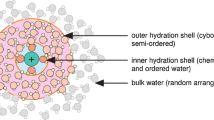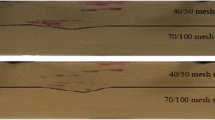Abstract
Visualization experiments using a rectangular transparent acrylic cell, which contained glass beads saturated with alkaline solution, with a universal pH indicator, were conducted to investigate the migration behaviors of gas and dissolved CO2 in water-saturated porous media, assuming that CO2 exsolution occurs from the CO2-saturated groundwater. Immediately after the CO2 gas injection (t < 1 s), which is comparable to the period immediately following CO2 exsolution, CO2 gas moved upward, percolating into the pores through various pathways. During CO2 gas injection (t > 1 s), CO2 gas bubbles continued to move upward to the interface between the saturated porous medium and air, while dissolving in the pore water. When the CO2 gas reached the interface, a thin, dense yellow layer was formed, followed by the gradual coalescing of the small fingers, forming a thick dense yellow layer, indicating density-driven convection. The fingers formed by the density-driven convective flow were clearer in the coarser glass beads. The migration of carbonated water was faster, as the glass bead size and the CO2 gas injection rate increased, causing earlier CO2 saturation in pore water. The temporal changes in the effluent CO2 gas concentration, emitted from the saturated glass beads to air, varied with the grain size of the porous medium and the CO2 gas injection rate.









Similar content being viewed by others
References
Amonette JE, Barr JL, Erikson RL, Dobeck LM, Barr JL, Shaw JA (2013) Measurement of advective soil gas flux: results of field and laboratory experiments with CO2. Environ Ear Sci 70(4):1717–1726
ASTM D 422–63 (2007) Standard test method for particle-size analysis of soils. ASTM International, West Conshohocken, PA
ASTM D 6836–16 (2016) Standard test method for determination of the soil water characteristic curve for desorption using hanging column, pressure extractor, chilled mirror hygrometer, or centrifuge. ASTM International, West Conshohocken, PA
Bang ES, Son JS, Santamarina JC (2012) Subsurface CO2 leakage: lab-scale study of salient characteristics and assessment of borehole-based detection using resistivity tomography. In: 4th International Conference on Geotechnical and Geophysical Site Characterization (ISC’4)
Brooks MC, Wise WR, Annable MD (1999) Fundamental changes in in situ air sparging flow patterns. Ground Water Monit Remediat 19(2):105–113
Cihan A, Corapcioglu MY (2008) The effect of compressibility on the rise velocity of an air bubble in porous media. Water Resour Res 44(W04409):1–8
Corapcioglu MY, Cihan A, Drazenovic M (2004) Rise velocity of an air bubble in porous media: theoretical studies. Water Resour Res 40(W04214):1–9
Dominguez A, Bories S, Prat M (2000) Gas cluster growth by solute diffusion in porous media. Experiments and automaton simulation on pore network. Int J Multiph Flow 26:1951–1979
Enouy R, Li M, Ioannidis MA, Unger AJA (2011) Gas exsolution and flow supersaturated water injection in porous media: II. Column experiments and continuum modeling. Adv Water Resour 34:15–25
Faisal TF, Chevalier S, Sassi M (2013) Experimental and numerical studies of density driven natural convection in saturated porous media with application to CO2 geological storage. Energy Proced 37:5323–5330
Foster LS, Gruntfest IJ (1937) Demonstration experiments using universal indicators. J Chem Educ 14(6):274
Gaus I (2010) Role and impact of CO2-rock interactions during CO2 storage in sedimentary rocks. Int J Greenh Gas Con 4:73–89
Geistilinger H, Krauss G, Lazik D, Luckner L (2006) Direct gas injection into saturated glass beads: transition from incoherent to coherent gas flow pattern. Water Resour Res 42:W07403
Holloway S (2005) Underground sequestration of carbon dioxide—a viable green-house gas mitigation option. Energy 30:2318–2333
IEA/OECD (2008) CO2 capture and storage—a key carbon abatement option. Organisation for Economic Co-operation and Development & International Energy Agency, Paris, p 266
IPCC (2007) Climate change 2007: Synthesis report. In: Pachauri RK, Reisinger A (eds) IPCC, Geneva, p 104
Ji W, Dahmani A, Ahlfeld DP, Lin JD, Hill IE (1993) Laboratory study of air sparging: air flow visualization. Ground Water Monit Remediat 13(4):115–116
Kneafsey TJ, Pruess K (2009) Laboratory flow experiments for visualizing carbon dioxide-induced, density-driven brine convection. Transp Porous Media 82(1):123–139
Kreft E, Bernstone C, Meyer R, May F, Arts R, Obdam A, Svensson R, Eriksson S, Durst P, Gaus I, Meer B, Geel C (2007) ‘‘The Schweinrich structure’’, a potential site for industrial scale CO2 storage and a test case for safety assessment in Germany. Int J Greenh Gas Con 1:69–74
Li X, Yortsos YC (1995) Theory of multiple bubble growth in porous media by solute diffusion. Chem Eng Sci 50(8):1247–1271
Mojtaba S, Behzad R, Rasoul NM, Mohammad R (2014) Experimental study of density-driven convection effects on CO2 dissolution rate in formation water for geological storage. J Nat Gas Sci Eng 21:600–607
Neufeld JA, Hesse MA, Riaz A, Hallworth MA, Tchelepi HA, Huppert HE (2010) Convective dissolution of carbon dioxide in saline aquifers. Geophys Res Lett 37:L22404
Oldenburg CM, Lewicki JL (2006) On leakage and seepage of CO2 from geologic storage sites into surface water. Environ Geol 50(5):691–705
Plampin M, Illangasekare T, Sakaki T, Pawar R (2014) Experimental study of gas evolution in heterogeneous shallow subsurface formations during leakage of stored CO2. Int J Greenh Gas Control 22:47–62
Polak S, Cinar Y, Holt T, Torsæter O (2011) An experimental investigation of the balance between capillary, viscous, and gravitational forces during CO2 injection into saline aquifers. Energy Proced 4:4395–4402
Porter ML, Plampin M, Pawar R, Illangasekare T (2015) CO2 leakage in shallow aquifers: a benchmark modeling study of CO2 gas evolution in heterogeneous porous media. Int J Greenh Gas Control 39:51–61
Roosevelt SE, Corapcioglu MY (1998) Air bubble migration in a granular porous medium: experimental studies. Water Resour Res 34(5):1131–1142
Sakaki T, Plampin M, Rawar R, Komatsu M, Illangasekare T (2013) What controls carbon dioxide gas phase evolution in the subsurface? Experimental observations in a 4.5 m-long column under different heterogeneity conditions. Int J Greenh Gas Control 17:66–77
Thomas C, Lemaigre L, Zalts A, D’Onofrio A, Wit AD (2015) Experimental study of CO2 convective dissolution: the effect of color indicators. Int J Greenh Gas Control 42:525–533
Zhao K (2010) Experimental investigation of air injection in saturated unconsolidated porous media. University of Science and Technology of China, Guangdong
Zhou X, Apple ME, Dobeck LM, Cunningham AB, Spangler LH (2013) Observed response of soil O2 concentration to leaked CO2 from an engineered CO2 leakage experiment. Int J Greenh Gas Control 16:116–128
Acknowledgements
This research was supported by the Korea Ministry of Environment (MOE) under the “K-COSEM Research Program” and the National Research Foundation (NRF-2017R1A2B4008238) of the Ministry of Science, ICT and Future Panning, Korea.
Author information
Authors and Affiliations
Corresponding author
Rights and permissions
About this article
Cite this article
Kim, JS., Jo, H.Y. & Yun, ST. Visualization of gaseous and dissolved CO2 migration in porous media. Environ Earth Sci 77, 301 (2018). https://doi.org/10.1007/s12665-018-7484-5
Received:
Accepted:
Published:
DOI: https://doi.org/10.1007/s12665-018-7484-5




